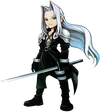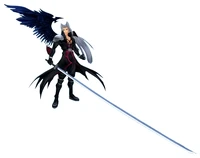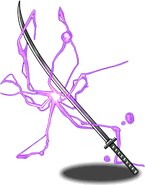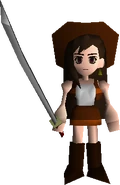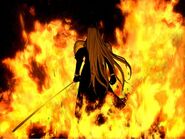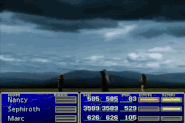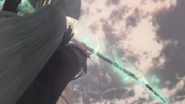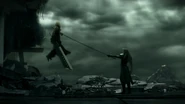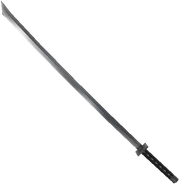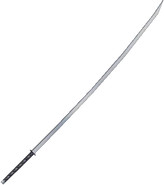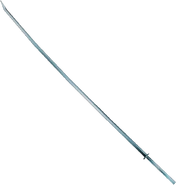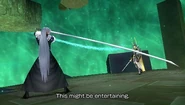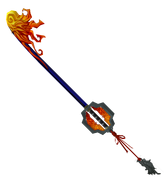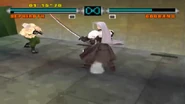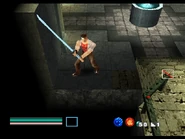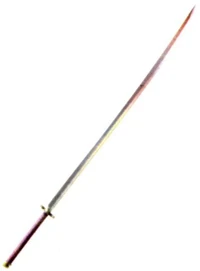
Artwork for Final Fantasy VII.
The Masamune (正宗, Masamune?) is Sephiroth's weapon in his various appearances in the Final Fantasy series and the Compilation of Final Fantasy VII. It is his version of the Masamune, a recurring katana in the Final Fantasy series that has recurred since the original Final Fantasy.
Design
The Masamune is designed as a Japanese odachi blade. The design and color of the tsuba (guard) and tsuka (hilt) have varied alternating between blue and gold and entirely black. The blade's exact length varies; usually measuring at least as long as Sephiroth is tall or slightly longer, which would make it approximately six-to-eight feet long. The angle of the curve of the blade also varies, but it is never entirely straight. The handle is more than long enough to accommodate both hands, but Sephiroth can carry it in one thanks to his unbelievable strength.
Appearances
Final Fantasy VII
Template:Sideicon
Said to be the only one capable of effectively using it, Sephiroth wields the Masamune as his personal weapon, but its origins are never stated. During the Nibelheim Incident Tifa Lockhart momentarily, and unsuccessfully, wields Sephiroth's Masamune against him.
While initially a physical blade, after his transference into the Lifestream Sephiroth can manifest multiple copies of the blade at will, as he leaves the sword impaled in his victims and still has it whenever he is encountered.
During the brief time Sephiroth is in the player's party, the Masamune is shown to possess six Materia slots in three linked pairs, zero Materia growth, a 255 Hit rate and 99 Attack power. It has a 100% critical hit rate. In his victory pose, Sephiroth swings Masamune in front of him twice, flips it over in his hand, and slides it curve-up against his waist so the hilt rests at his side and the blade faces up at an angle behind him.
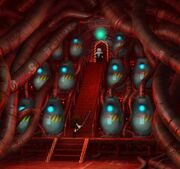
Tifa wielding the Masamune.
A replica of the Masamune can be acquired as an item in the Speed Square of the Gold Saucer, but it is a bonus item and cannot be equipped by any member in the party.
In the PC version, using a save editor, it is possible to equip the Masamune to Vincent, since he shares his stats and weapon data with Sephiroth. Even if it is possible to use the Masamune with Vincent, it is not as a katana, but as a gun; it is silver, and if struck on an enemy it uses the slash animation used by Sephiroth when he strikes and is more powerful than the Death Penalty, Vincent's ultimate weapon.
Final Fantasy VII: Advent Children
Template:Sideicon
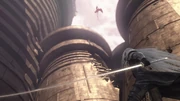
The Masamune.
Sephiroth manifests the Masamune into his hand upon his transformation from Kadaj. Wielding the blade against Cloud Strife and his new Fusion Swords, Sephiroth demonstrates the blade's power by slicing through several metal structures, pillars and concrete wreckage. Sephiroth is beaten by Cloud's Omnislash Version 5 that uses all of the Fusion Swords in one successive attack.
The movie's revised version, Final Fantasy VII: Advent Children Complete, adds an auditory characteristic to the blade, which now hums in a similar manner to crystal when struck by wind. The scene where Sephiroth stabs Cloud in the shoulder during their fight is reedited to mimic Cloud's original impalement during the Nibelheim Incident.
Before Crisis -Final Fantasy VII-
Template:Sideicon
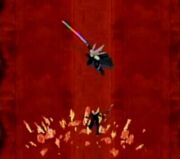
Sephiroth attacks the Player Turk during the Nibelheim Incident.
Sephiroth, with the Masamune, has brief cameo appearances where he supports the forces of the Shinra Electric Power Company in their battle against the terrorist group AVALANCHE.
Crisis Core -Final Fantasy VII-
Template:Sideicon
Appearing in Sephiroth's hands in all battle encounters, the Masamune is not seen on Sephiroth's person during instances where he is not battling.
Sephiroth matches the speed and deftness of fellow 1st Class SOLDIERs, Angeal and Genesis, in spite of the pair wielding shorter weapons and attacking him at the same time. He demonstrates the blade's power by cleaving the Sister Ray's barrel into various segments as he assails Genesis in the Virtual Reality System.
A Sephiroth clone is available to combat in Hojo's Laboratory, Experiment No. 124, which wields a copy of the Masamune.
Last Order -Final Fantasy VII-
Template:Sideicon In the anime OVA covering the Nibelheim Incident, Zack's Final Stand and the events in-between, Sephiroth, with the Masamune, massacres townspeople before making his way to the Nibel Reactor. Tifa's brief wielding of the blade after having watched her father die is also shown.
Non-specific appearances
Since the Masamune is Sephiroth's iconic weapon, the non-specific appearances of the blade are related with Sephiroth's appearances in other games, like Dissidia Final Fantasy, Dragon Quest & Final Fantasy in Itadaki Street Special and Ehrgeiz: God Bless the Ring.
Non-Final Fantasy guest appearances
Ehrgeiz: God Bless the Ring
Sephiroth's sword.
Description
The Masamune appears as a 2-handed sword within the Forsaken Dungeon. It provides 98 Weapon Atk, 8 Durability, +7 Magic Atk, -3 Speed, and -2 Consumption Rate. Only Masuda Koji can equip this weapon. Sephiroth can wield the Masamune during Arcade Mode.
Kingdom Hearts series
Sephiroth summons the Masamune to battle as he acts as Cloud Strife's personified darkness. While frequently engaging Cloud in battle, Sephiroth also battles Sora first as a trial in the Colosseum and then on his own interest. In both encounters Sephiroth wields the Masamune in his off hand, following the trend of the principle Final Fantasy cast seeming to give Sora various alleviances in their battles.
In Kingdom Hearts Final Mix, Kingdom Hearts: Chain of Memories and its remake, Kingdom Hearts Re:Chain of Memories, the One-Winged Angel Keyblade is modeled after Sephiroth's Masamune.
Puzzle & Dragons
The Masamune appeared as part of the Final Fantasy collaboration.
Merchandise
Sephiroth's Play Arts action figures come with a Masamune.
Gallery
Etymology and symbolism
The Masamune is named after Masamune Okazaki, a legendary Japanese blacksmith of the Kamakura Era employed under the Kamakura Shogunate. He was famous for his forging process of soshu kitae and nijuba, the strongest method for the body of katana, layering different consistencies of carbon steel for tensile composition and in such a way they were forged twice, and cultivating the aesthetics of katana through having refined and merged traits of quality with those of beauty.
His works were often compared to those of Muramasa, and sometimes mistaken for the other in fiction or fantasy novels, though always the better of the two. According to legend, the two swordsmiths set a sword of their making into a nearby stream as contest to see who made the better sword, with Masamune's blade said to have ignored all things that came near it. Though Muramasa belittled Masamune, a monk came to be the final judge and praised Masamune's swords for having benevolence, cutting only what it was meant to cut while Muramasa's cared little for what it cut. From this tale, Masamunes are said to be the marks of an internal peaceful and calm warrior, the opposite of Muramasas who were deemed bloodthirsty and cursed blades. All legends of the two ever having met are historically impossible since they were from different time periods.
According to development notes by character designer and creator Tetsuya Nomura, Sephiroth's design was inspired by the legendary samurai swordsman Sasaki Kojiro. In turn, Cloud Strife is based on his more prodigious rival, Musashi Miyamoto. Sasaki is said to have wielded a notably long nodachi, allegedly created by Bizen Osafune Nagamitsu.
While a Masamune would seem historically inaccurate for a character based on Sasaki Kojiro, the traits of its appearance and identity as a weapon for Sephiroth tie into various influences of Japanese culture. Within Japanese martial arts fiction, it is a common archetype to portray stronger adversaries with seemingly greater attributes than the challenging protagonist. The perversion of something sacred to be used for evil has its roots in Buddhism and Japanese philosophy. Especially the 1990s anime, manga, and video games had a trend to showcase the impermanence of definite right and wrong, including how the hallowed and deified could go down an evil route. Kojiro and Musashi have had a long tradition of being portrayed in premodern popular culture, including the earliest forms of manga and urban legends.
Within the art of Japanese sword-making, kenso is aesthetic appreciation revolving around the divination of surface patterns and physical attributes of finished swords to uncover the kind of spirit that a katana has when made. While many individual schools of katana-making have their own lexicons and defining attributes, there also exists a commonly shared ground of divination aesthetics in the nation of Japan. For Masamune, his attributes of kenso are said to be extremely powerful, responsible for his swords gaining the reputation of being sacred weapons. One kenso trait of his swords is the folding fan shapes within its patterns, or ogiba. While the folding fan is considered an auspicious symbol of high class and great luck, it is also considered to be related with the invigoration of the spirit and closeness to the heavens, as the folding fan is said to be used as a divine receptor to channel the kami of Shinto faith into the being of a person during seances and kagura (dance to pacify deities) performances. Finally, the divination of kenso is said to have been done to ensure a weapon matches its wielder, so the katana would share the same spirit as its owner. It may be argued that this explains Sephiroth's use of the weapon, significant of his perversion into madness and godhood, as this signifies that he may be "channeled" by Jenova or the other way around.
Trivia
- The Japanese (odachi, 野太刀:のだち?), on which the appearance of the Masamune is based, is a large two-handed Japanese long-sword carried by foot soldiers as a weapon against cavalry soldiers. They were generally used on open battlefields as the weapon's length made their use indoors or close quarters difficult. During times of peace the sword was worn slung across the back as a symbol of status as it required considerably more strength and skill to wield than a conventional katana.
- Man at Arms have created a real life version of the Masamune. Compared to the Buster Sword, the Masamune is supposedly easier to handle if these weapons were to appear in real life.
- Although odachi are designed to slash, Sephiroth's infamous method of killing his targets is impalement.



